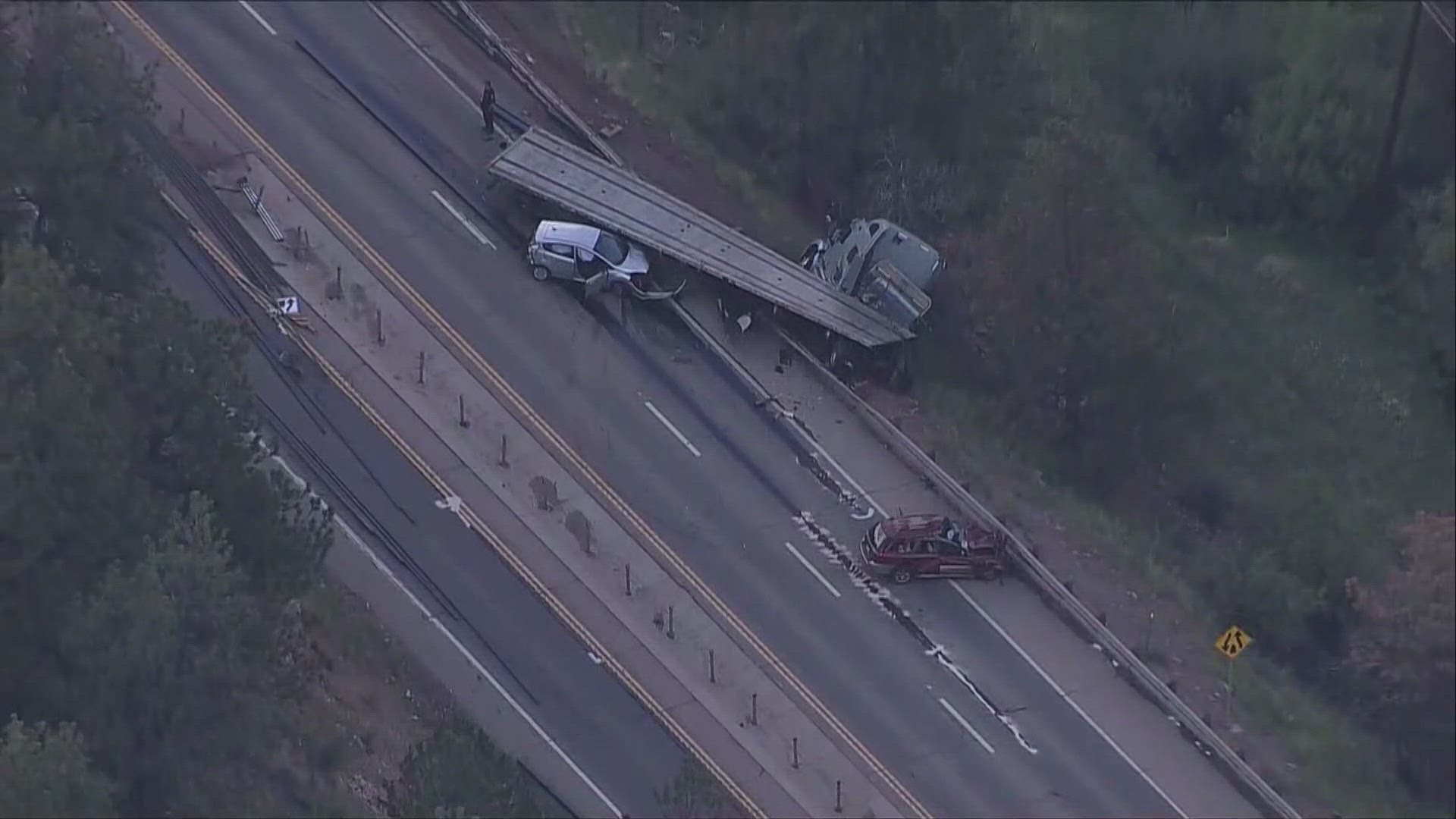JEFFERSON COUNTY, Colo. — The most recent crash on Highway 285 at Shaffers Crossing kept a major roadway closed overnight into Wednesday morning.
Statistics from the Colorado State Patrol (CSP) show it is at least the fifth accident at or within two miles of Shaffers Crossing this year.
If you go back 11 years, the number of accidents in that two-mile stretch of Highway 285 reaches 285.
“There’s people with bumper stickers that say, ‘Pray for me, I drive 285 every day,’” Barb Halverson said.
Halverson lives near Kings Valley, just north of Shaffers Crossing. She describes her daily commutes in a unique way: life or death.
“I finally bought myself one of those cameras, car cameras, just because I’m going to get hit one of these days, and I want to be able to prove to the insurance company that it wasn’t my fault,” Halverson said. “Or to be able to say goodbye to my kids because I’ve been killed.”
Early Tuesday evening, a semi-truck went off the road at Shaffers Crossing, dropping a load of pipe and angle iron. That load landed on five vehicles. One person in a vehicle was killed.
The semi went through the cable barriers in the median and through the guard rail and dangled off the edge of the roadway.
“We need to understand what types of crashes have happened in the area, why they're happening and what are the types of crashes that we can potentially prevent or mitigate,” Colorado Department of Transportation (CDOT) spokesman Matt Inzeo said. “What are the sorts of things that we can solve for, knowing that there’s not one single, perfect solution, particularly in an area like this?”
Highway 285 is CDOT’s responsibility, but accidents are investigated by CSP. In records dating back to Sept. 2011, CSP has recorded 338 accidents within a two-mile stretch of Shaffers Crossing.
“If you’re talking about steep grades, sharp curves and the potential for high speeds, you’re going to have a problem area,” Inzeo said.
In 2016, CDOT installed cable barriers in the median. It was a response to several head-on crashes and near misses. Southbound traffic has two lanes. Northbound traffic has one.
“We almost got hit head-on once down there. Our son was driving, and someone was coming. It’s two lanes going down the hill and one lane going up. We were going up the hill. He was going down and decided he needed three lanes, and luckily my son was smart enough to get out the way,” Halverson said.
Before 2016, there was no barrier in the median. CDOT was originally going to install concrete jersey barriers but instead chose cable barriers because of the concern of creating a new hazard in the winter.
The concern was that snowplows would not be able to get all the snow off the highway and leave snow piled against the barrier, which would thaw and melt across the road during the day and freeze in the cold temperatures at night.
“The specific concerns that can come with freeze-thaw conditions are the fact that you can have what is otherwise a very nice day, and someone can hit a stretch of road where, quite reasonably, they wouldn’t expect to see an icy patch, and they can hit it. That’s a really severe hazard that we need to be very careful to avoid,” Inzeo said.
“We need law enforcement, some kind of barrier, whether that’s concrete, wire, something to keep people in their own lanes,” Halverson said.
Both Halverson and Inzeo point out that drivers who go too fast are a problem that can be fixed without changing the look of the road.
“You’re talking about a really steep grade, with some really sharp curves, and with those ingredients, we always worry about speed as well,” Inzeo said.
The speed limit is 45 mph, with a flashing sign for southbound drivers warning them to slow down.
As for the road configuration, there is a mountain on one side and a steep drop-off on the other, leaving little room for a redesign.
“The road needs to be repaired. We’ve got potholes. The shoulders are horrible, but if you go off, you’re lost. It’s not just the barriers, there’s a lot of work that needs to be done,” Halverson said.
“There’s always going to be trade-off with the infrastructure that we put into a given area. We want to understand those trade-offs as specifically as possible to make the best decisions possible,” Inzeo said.
According to CSP, Highway 285 is the highway with the fifth-most speeders ticketed for going more than 20 mph faster than the speed limit.
In 2023, CSP issued 791 tickets to drivers going faster than 20 mph on all of Highway 285, not just near Shaffers Crossing.
The number one area for CSP tickets of 20 mph or faster is Interstate 70, with 3,047 tickets last year.
Interstate 25 saw 1,992 tickets.
Drivers on Highway 50 through southern Colorado saw 1,367 tickets.
Highway 24 through the central mountains and eastern plains was number four on the list of most tickets for driving 20 mph or faster, with 979 tickets.
SUGGESTED VIDEOS: Next with Kyle Clark

